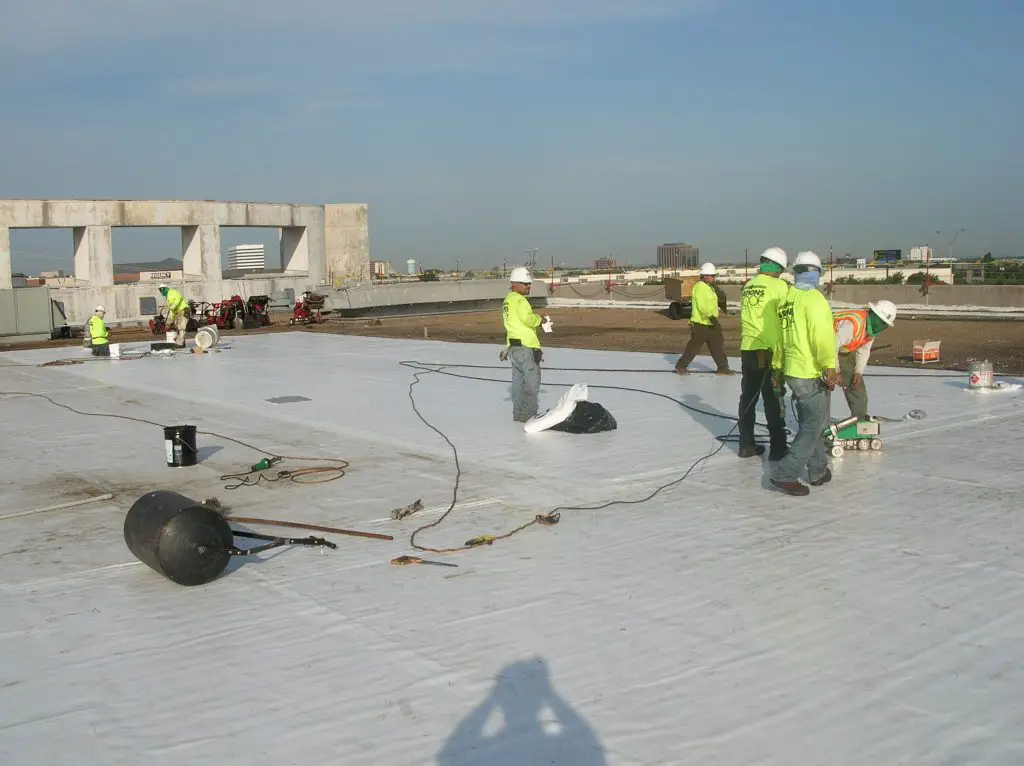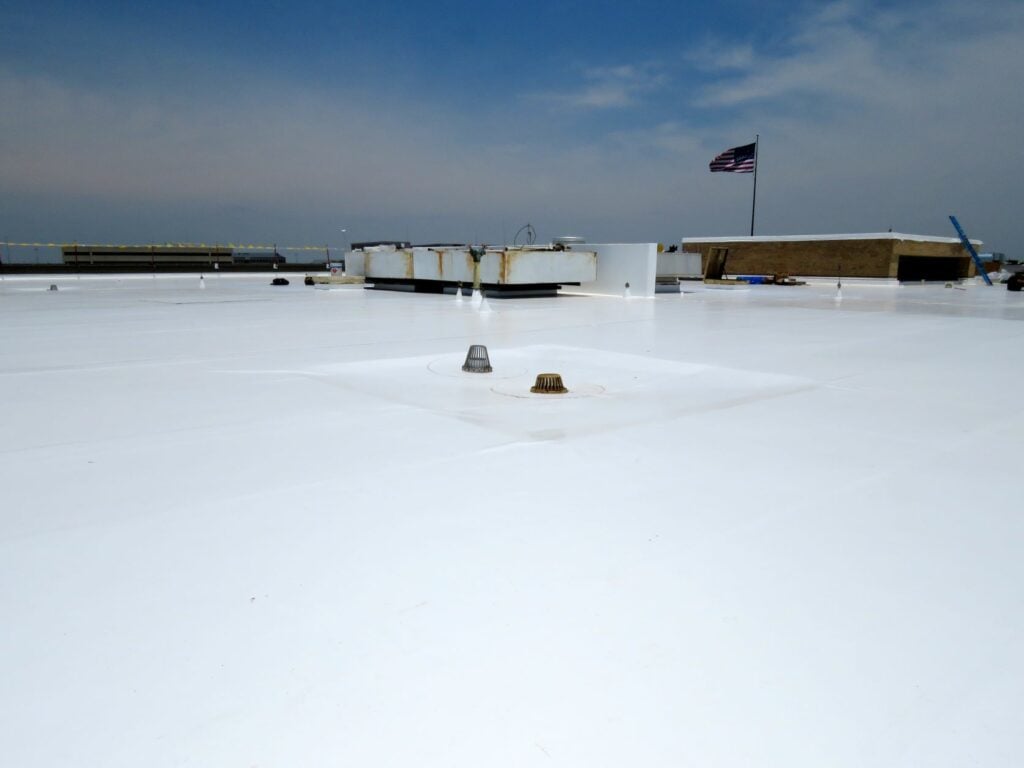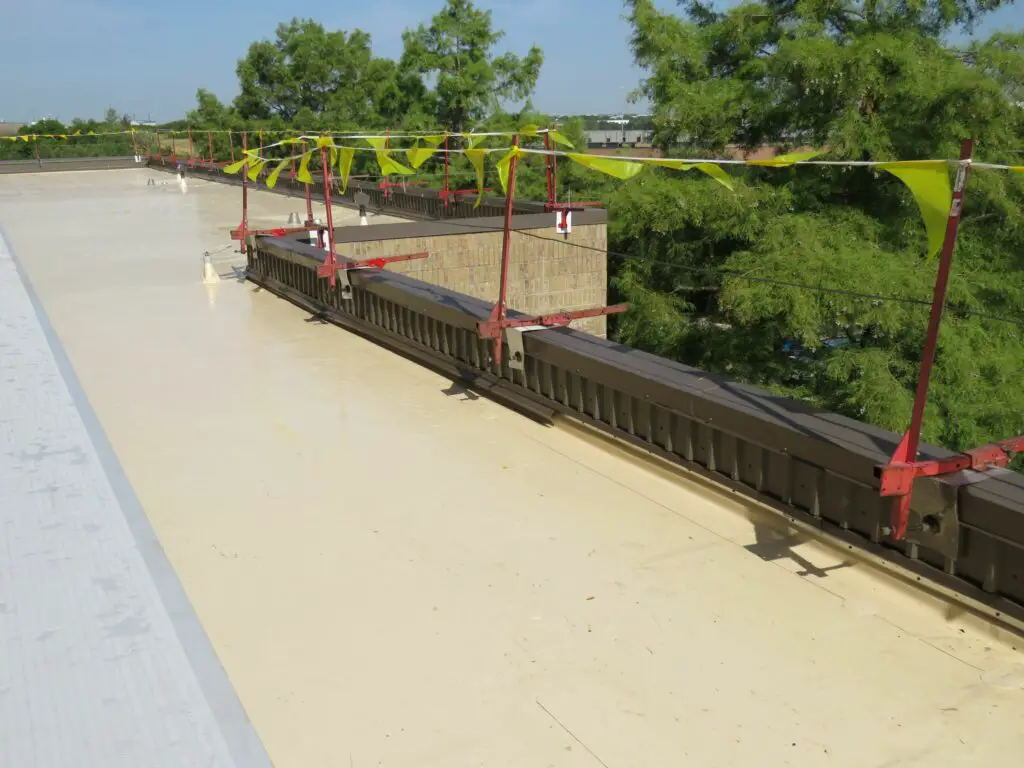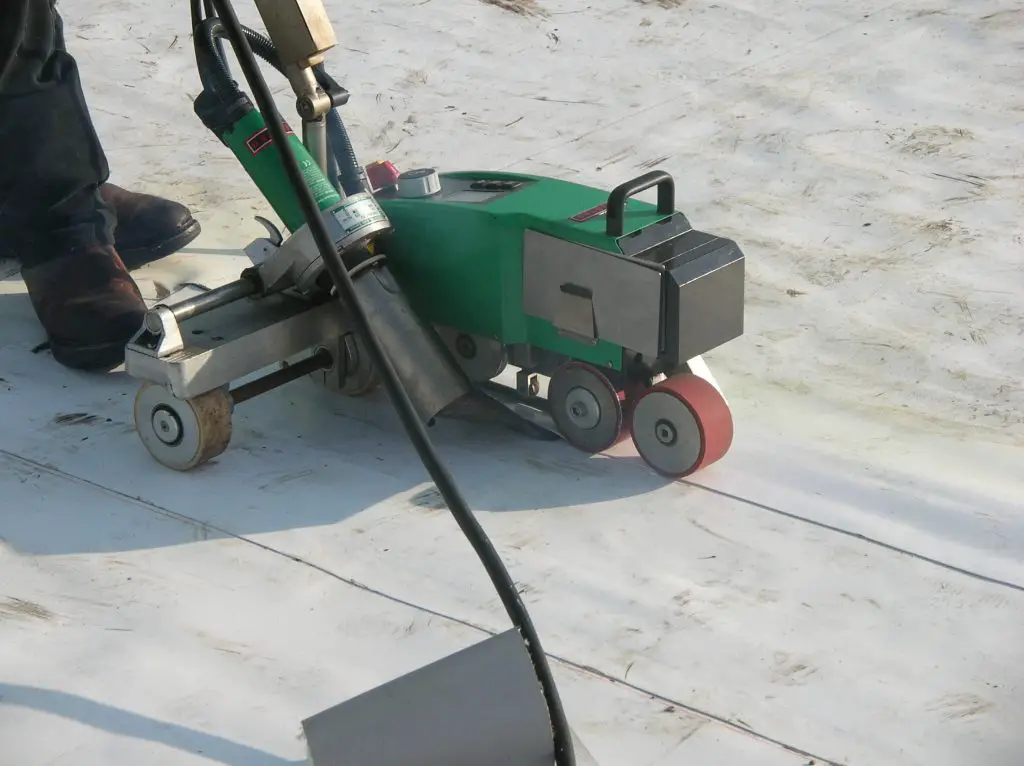PVC Roofing • Pros, Cons, Membranes, Lifespan & More
By Jack Gray, Roof Online Editor • Last updated September 28, 2023

Table of Contents
Introduction
PVC (polyvinyl chloride) roofing is a type of flat or “low slope” roofing system widely used in commercial and industrial building construction.
PVC roofing systems were introduced in the late 1960s, and after they had some initial issues resolved in the 80s, they now have a record of proven performance going back almost 40 years.
After TPO and EPDM, PVC membranes are the third-most-popular type of single-ply membranes used on commercial buildings. PVC membranes also have a few appropriate applications when it comes to residential roofing.
Few building owners know much about the technical aspects of a PVC roofing system (and often confuse a PVC membrane with a TPO membrane). Since PVC is a low-slope roofing system, you would need to have a low-slope roof (or sections of flat roof on your house or building) for it to make sense for you to bother learning about it.
But if you do have a roof like that, then membrane roofing is probably right for your building, and you should learn the basics of PVC roofing systems so you can make a more informed decision when it’s time for you to choose a roofing material for your next roofing project.
As a professional roof consultant, I’ve been designing, specifying, and inspecting PVC roofing systems for over 20 years. I’ve also spent a lot of time as a quality assurance observer during PVC roof installations.
(Quality assurance observation means that you stand on the roof during the installation and watch everything that goes on during the job.
You make sure that the roofing contractor is installing the material according to best practices, the manufacturer’s recommendations, and the consultant’s specifications for that particular roof.)
I’ve learned a lot about PVC roofing, and I thought it might be helpful if I shared some of what I know here on our website.

What is a PVC roofing membrane?
A PVC roofing membrane is a popular type of thermoplastic single-ply roofing membrane commonly used in commercial and industrial roofing, with more limited use in residential roofing.
PVC stands for polyvinyl chloride, which is a well-known type of plastic, but a PVC roofing membrane is not quite the same material as the rigid PVC used for pipes or house trim.
A PVC roofing membrane has plasticizers added to the material when it’s manufactured so it stays flexible and easy to work with. A polyester or fiberglass reinforcement fabric mat is sandwiched between two layers of plasticized PVC to produce the final product.
These plasticizers very slowly migrate out of the membrane over time. A very old PVC roof membrane may be noticeably less flexible than a new one.
By comparison, TPO membranes do not need or use plasticizers. While TPO is less flexible than PVC during an initial roof installation, after a couple of decades it’s the other way around.
PVC membrane thickness
PVC roof membranes come in several different thicknesses. The most common thicknesses are 50 mils, 60 mils, and 80 mils. A mil is 1/1000 of an inch. A 60-mil PVC membrane is 1.52 millimeters thick.
Most of the thickness of a PVC roof is due to the cover board and insulation that is installed under the roof membrane. A finished commercial PVC roof will normally be 4 to 6 inches thick (due to current insulation R-value requirements).
The thicker the PVC roof membrane is, the longer the roof can be expected to last (everything else being equal). The thicker the membrane is, the more it will cost, as well.
Available colors for PVC roofs
PVC roofing systems are usually white, and they reflect the sun’s rays and reduce the amount of heat absorbed by your building. Building owners looking for reflective roofing materials that will qualify as a “cool roof” should definitely consider a PVC roof.
Other standard colors include tan and gray, and manufacturers will produce PVC in custom colors if your order is big enough (you usually need to order at least 50,000 square feet to get a custom color).

Performance of PVC roofing materials
PVC roofing membranes are known for holding up well when exposed to ultraviolet rays, and various chemicals; they resist algae growth, and compared to EPDM, they are highly resistant to kitchen grease and foot traffic.
When compared to a TPO membrane (thermoplastic polyolefin), which is its main competitor, it’s exceptionally fire resistant.
Important things to know about a PVC roofing membrane
Here are a few of the important things you should know about a PVC roofing membrane.
When to use a PVC roofing membrane
If a roof (or a section of a roof) has a slope less than 3/12, it’s considered a low-slope roof. While asphalt shingles can technically be installed on a roof pitch as low as 2/12, and the building code allows it, it’s a good idea to go with a single-ply system on a roof pitch under 3-in-12. You can read more about roof pitch here.
Shingle or tile roof systems are not waterproof, rather they are water-shedding, and depend on gravity to get water off the roof quickly. They need a steeper slope to function properly, otherwise standing water or wind-driven rain can enter the roof under the shingles.
Flat roof systems like PVC membranes present a monolithic, waterproof surface that water can’t get through. This is why they are either required or strongly recommended for flat roofs.
How are PVC roofs installed?
First of all, you should look for contractors who specialize in PVC membrane to install (or repair) your PVC roof. A PVC roofing installation takes specialized equipment and experience (and it’s a little different than TPO, no matter what the contractor tells you).
PVC roofing assemblies typically include the roof deck, a vapor barrier as needed, a layer of insulation board, a cover board, and the membrane itself.
Attachment methods
PVC membranes can be mechanically attached, where rows of fasteners through batten strips hold the membrane in place. It can also be fully adhered, where the other layers of the roof system can be secured using either fasteners or adhesives, but the membrane itself is glued to the cover board with adhesives applied to the underside of the entire membrane.

Mechanically attached systems are cheaper, but more appropriate for large commercial roofs. I believe fully adhered systems should always be used in residential roofing applications. Fully adhered systems tend to last longer and look better.
Heat welding
PVC is a thermoplastic material like TPO. The individual sheets of PVC are seamed together by heat welding. Special hot air tools heat the edges of two pieces of the PVC roofing material to around 1,100°F, and they are pressed together with a roller to create a bond at the seams.
These heat welds have more tensile strength than the regular membrane itself. The PVC flashings at the edges of the roof and penetrations are heat-welded as well. This process is also used for patching and other repairs.

How long will a PVC roofing membrane last?
The lifespan of a 60-mil fully-adhered PVC membrane is around 25 or 30 years if it’s installed and maintained properly, and you can typically get a 20-year material warranty. Other thicknesses and attachment methods have other life expectancies and warranty lengths, and you can learn more about the life expectancy of PVC roofing systems here.
The factors that affect roof lifespan always include the quality of the installation, the type of roofing material, the thickness and quality of the materials, roof maintenance, and the local climate.
How much does a PVC roofing system cost?
The cost of any roof installation depends on constantly fluctuating material prices and local labor costs. Furthermore, these costs can vary wildly from place to place, so it’s almost impossible to make an accurate blanket statement about it.
The price of PVC roofing includes insulation that may have to be several inches thick, depending on the R-value required by the local building code.
One thing I can tell you is that PVC typically costs a bit more than TPO, about the same as EPDM, and about twice as much as asphalt shingles. That said, PVC roofing will probably cost you anywhere from $10 to $18 per square foot.
Smaller jobs will cost more per square foot, as will jobs where there are a lot of flashings to install (lots of skylights, etc.). Very large roofs with hardly any penetrations will be the cheapest per square.
Does a PVC roof need to be cleaned?
To keep the cool roof benefits of a PVC roofing membrane, you’re going to have to clean the roof every 2 years or so. If you want it to stay reflective, you have to keep the roof clean, they’ve done studies.
Both commercial and residential roofs get incredibly dirty, and because PVC roofing systems are white, they really show the dirt. This is something to keep in mind if people are going to be able to see the roof.
As I mentioned, they do make PVC membranes in tan and gray, which might be a better idea, and you don’t lose as much solar reflectance as you might think.
Conclusion
I hope this article helped you out and served as a decent introduction to PVC roofing. If you want to learn more about PVC roofing materials, the links below are a good place to start.
About the Author
Jack Gray is a principal roof consultant and vice president at the Moriarty Corporation, an award-winning building enclosure consultant firm founded in 1967. He is also the editor of the Roof Online website.

Mr. Gray has worked in the roofing industry for over 25 years, with training and practical experience in roof installation, roof inspection, roof safety, roof condition assessment, construction estimating, roof design & specification, quality assurance, roof maintenance & repair, and roof asset management.
He was awarded the Registered Roof Observer (RRO) professional credential in 2009.
He also served as an infantry paratrooper in the 82nd Airborne Division and attended Cornell University. Read full bio.
Related Articles
- EPDM Roofing Introduction
- PVC Roofing Cost Guide
- PVC Roofing Manufacturers List
- TPO Roofing Introduction
- Types of Single Ply Roof Membranes
External Sources & References for PVC Roofing Information
1. Book Recommendation: Manual of Low-Slope Roof Systems: Fourth Edition by C.W. Griffin & Richard Fricklas
2. General: The Vinyl Roofing Division of the Chemical Fabrics and Film Association is a good (if possibly a little biased) source of information on PVC roofing. It “was created to educate architects, specifiers, building owners and roofing contractors on the attributes of PVC as a durable, reflective, heat-weldable material for single-ply roofing systems.”
3. General: See this in-depth general article about various roof systems on the Whole Building Design Guide site, which is maintained by the National Institute of Building Sciences.
4. Building Codes: “R905.13 Thermoplastic Single-Ply Roofing” from the 2018 International Residential Code and “1507.13 Thermoplastic Single-Ply Roofing” from the 2018 International Building Code. Both available on the UpCodes website.
5. Chemical Compatibility of PVC: Take a look at this list of chemicals/substances and whether you can expect them to damage PVC. Chart is made available by GAF.
6. Safety: See this material safety data sheet for health and safety information about PVC roofing at the GAF website. This is only an example and other products and brands may be different.
7. Technical: See this PVC roof installation guide to see what’s going on in a typical PVC roof system. This guide is available at the Johns Manville website.
8. Technical: See this product data sheet for the technical characteristics of PVC roofing at the Johns Manville website. This is only an example and other products and brands may be different.